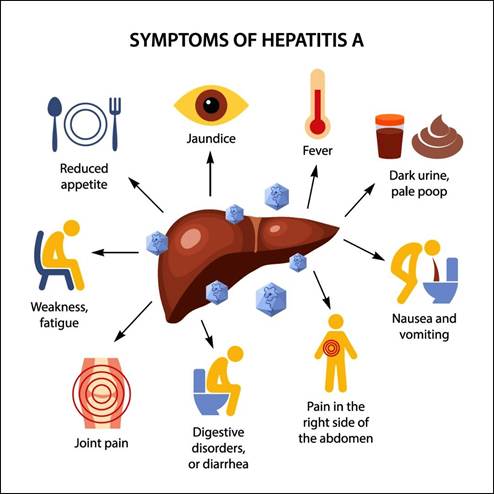Why in news?
- India is debating including the Typhoid Conjugate Vaccine (TCV) in the Universal Immunisation Programme (UIP).
- Experts argue that Hepatitis A vaccination deserves even higher priority because the disease burden is shifting toward adolescents and adults — groups at significantly higher risk of severe disease, including acute liver failure.
- The article highlights that an effective indigenous Hepatitis A vaccine exists, yet policy inclusion is pending.
Relevance
- GS 2 – Health / Immunisation
UIP expansion; vaccine policy; epidemiological transition - GS 3 – Public Health
Outbreak management; sanitation transition; acute liver failure - GS 2 – Governance & Policy
Evidence-based policymaking; cost-effectiveness; indigenous vaccine development

Basics: what is Hepatitis A?
- Acute viral liver infection typically mild in young children.
- Historically: >90% Indians exposed in childhood → lifelong immunity.
- Current shift: improved sanitation → fewer children infected early → more susceptible adolescents & adults.
- Severe disease in older age groups → acute liver failure, hospitalisation, deaths.
- No specific antiviral treatment → only supportive care.
Changing epidemiology
- Seroprevalence (protective antibodies) dropping from ~90% to <60% in many urban regions.
- Outbreaks reported in Kerala, Maharashtra, Uttar Pradesh, Delhi.
- Clusters of acute liver failure in hospitals show rising severity.
- Hepatitis A now an emerging public-health threat, not a benign childhood disease.
Hepatitis A vs Typhoid: key contrasts
Disease burden
- Typhoid mortality declining with antibiotics + sanitation.
- Hepatitis A rising in older children/adults → more severe outcomes.
Treatment
- Typhoid: antibiotics available; AMR emerging but treatable.
- Hepatitis A: no specific treatment, recovery depends entirely on supportive care.
Vaccine characteristics
- Hepatitis A vaccines:
- 90–95% efficacy
- Single dose for live vaccine
- Long-lasting (15–20 years to lifelong)
- No issues of waning immunity or resistance
- Typhoid vaccines: require multi-dose cycles in some settings; immunity relatively shorter.
Programmatic simplicity
- Hepatitis A vaccine is single-dose, easy to integrate with existing booster schedules.
- Indigenous product (Biovac-A by Biological E) has two decades of excellent use in private sector.
Cost-effectiveness
- Hepatitis A: high-cost outbreaks, expensive hospitalisation, severe disease in adults → strong economic rationale for universal vaccination.
- Typhoid: important but lower immediate cost-effectiveness because mortality has declined.
Why Hepatitis A deserves priority
- Growing susceptible population: fewer children infected early → rising young adult vulnerability.
- Severe disease profile: adult infection = higher hospitalisation + acute liver failure risk.
- No treatment: prevention via vaccination is the only effective shield.
- Low-hanging fruit:
- Single dose
- Long-term immunity
- Indigenous supply available
- Clear scientific evidence: declining antibodies + frequent outbreaks.
Recommended strategy for India
- Adopt a phased introduction, aligned with UIP’s proven approach:
- Start with States facing repeated outbreaks or low seroprevalence.
- Co-administer with DPT or MR boosters to use existing systems.
- Conduct periodic serosurveys to monitor immunity levels.
- Gradually expand to national scale.
Public health rationale
- Fits UIP tradition of proactive shifts (Hepatitis B, Rotavirus, Pneumococcal).
- Helps prevent avoidable severe disease and hospital burden.
- Reduces long-term healthcare costs by preventing liver complications early.
Overview
Epidemiological relevance
- The shift from early childhood exposure to adolescent vulnerability reflects India’s sanitation transition.
- Parallel seen previously in East Asia and Latin America before they introduced universal Hepatitis A vaccination.
- Without vaccination, India risks repeated outbreaks and rising adult mortality from acute liver failure.
Programmatic feasibility
- Single-dose administration makes planning efficient.
- Indigenous production ensures supply security and affordability.
- Can be rapidly scaled using existing UIP logistics.
Economic considerations
- Adult hospitalisations for Hep A are expensive (ICU care, liver monitoring, long recovery).
- Vaccination cost per child is low compared to treatment cost.
- Higher workforce productivity because adults are protected.
Policy gap
- Scientific consensus is strong, but policy action is lagging, unlike for TCV where debate is ongoing.
- No technical barrier: the missing piece is only political and administrative decision-making.



